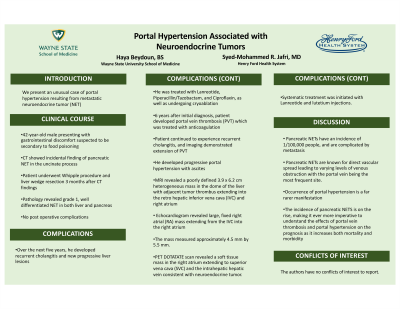Monday Poster Session
Category: Liver
P2478 - Portal Hypertension Associated with Neuroendocrine Tumors
Monday, October 23, 2023
10:30 AM - 4:15 PM PT
Location: Exhibit Hall

Has Audio

Haya Beydoun, BS
Wayne State University
Detroit, Michigan
Presenting Author(s)
Haya Beydoun, BS1, Syed-Mohammed Jafri, MD2
1Wayne State University, Detroit, MI; 2Henry Ford Health System, Detroit, MI
Introduction: We present an unusual case of portal hypertension resulting from metastatic neuroendocrine tumor (NET).
Case Description/Methods: A 42-year-old male presented with gastrointestinal discomfort suspected to be secondary to food poisoning. After a CT scan, he was incidentally diagnosed with a pancreatic neuroendocrine tumor in the uncinate process . He underwent a Whipple procedure and a liver wedge resection three months later. Pathology confirmed grade 1, well differentiated NET in both liver and pancreas. He had no postoperative complications. Over the next five years, he developed recurrent cholangitis and new progressive liver lesions. He was treated with Lanreotide, Piperacillin/Tazobactam, and Ciproflaxin, as well as undergoing cryoablation. The patient developed portal vein thrombosis (PVT),6 years after the initial diagnosis, which was treated with anticoagulation. The patient continued to experience recurrent cholangitis and imaging demonstrated extension of PVT. He developed progressive portal hypertension with ascites. Magnetic Resonance Imaging (MRI) revealed a poorly defined 3.9 x 6.2 cm heterogeneous mass in the dome of the liver with adjacent tumor thrombus extending into the retrohepatic inferior vena cava (IVC) and right atrium. Echocardiogram revealed large, fixed right atrial (RA) mass extending from the IVC into the right atrium. The mass measures approximately 4.5 mm by 5.5 mm. Further evaluation with Positron Emission tomography (PET) DOTATATE scan revealed a soft tissue mass in the right atrium extending to superior vena cava (SVC) and the intrahepatic hepatic vein consistent with neuroendocrine tumor. Systematic treatment was initiated with Lanreotide and lutetium injections.
Discussion: With an incidence of 1 in 100,000 people, pancreatic neuroendocrine tumors are rare. Metastasis can complicate the clinical course of neuroendocrine tumors. Pancreatic neuroendocrine tumors are known for direct vascular spread which leads to varying levels of venous obstruction.The portal vein is the most frequent site of tumor thrombosis due to invasion of primary or secondary tumors. Occurrence of portal hypertension is a far rarer manifestation. The incidence of pancreatic neuroendocrine tumors has been on the rise, making it ever more imperative to understand the effects of portal vein thrombosis and portal hypertension on the prognosis. In patients with pancreatic endocrine tumors, portal hypertension increases both mortality and morbidity.
Disclosures:
Haya Beydoun, BS1, Syed-Mohammed Jafri, MD2. P2478 - Portal Hypertension Associated with Neuroendocrine Tumors, ACG 2023 Annual Scientific Meeting Abstracts. Vancouver, BC, Canada: American College of Gastroenterology.
1Wayne State University, Detroit, MI; 2Henry Ford Health System, Detroit, MI
Introduction: We present an unusual case of portal hypertension resulting from metastatic neuroendocrine tumor (NET).
Case Description/Methods: A 42-year-old male presented with gastrointestinal discomfort suspected to be secondary to food poisoning. After a CT scan, he was incidentally diagnosed with a pancreatic neuroendocrine tumor in the uncinate process . He underwent a Whipple procedure and a liver wedge resection three months later. Pathology confirmed grade 1, well differentiated NET in both liver and pancreas. He had no postoperative complications. Over the next five years, he developed recurrent cholangitis and new progressive liver lesions. He was treated with Lanreotide, Piperacillin/Tazobactam, and Ciproflaxin, as well as undergoing cryoablation. The patient developed portal vein thrombosis (PVT),6 years after the initial diagnosis, which was treated with anticoagulation. The patient continued to experience recurrent cholangitis and imaging demonstrated extension of PVT. He developed progressive portal hypertension with ascites. Magnetic Resonance Imaging (MRI) revealed a poorly defined 3.9 x 6.2 cm heterogeneous mass in the dome of the liver with adjacent tumor thrombus extending into the retrohepatic inferior vena cava (IVC) and right atrium. Echocardiogram revealed large, fixed right atrial (RA) mass extending from the IVC into the right atrium. The mass measures approximately 4.5 mm by 5.5 mm. Further evaluation with Positron Emission tomography (PET) DOTATATE scan revealed a soft tissue mass in the right atrium extending to superior vena cava (SVC) and the intrahepatic hepatic vein consistent with neuroendocrine tumor. Systematic treatment was initiated with Lanreotide and lutetium injections.
Discussion: With an incidence of 1 in 100,000 people, pancreatic neuroendocrine tumors are rare. Metastasis can complicate the clinical course of neuroendocrine tumors. Pancreatic neuroendocrine tumors are known for direct vascular spread which leads to varying levels of venous obstruction.The portal vein is the most frequent site of tumor thrombosis due to invasion of primary or secondary tumors. Occurrence of portal hypertension is a far rarer manifestation. The incidence of pancreatic neuroendocrine tumors has been on the rise, making it ever more imperative to understand the effects of portal vein thrombosis and portal hypertension on the prognosis. In patients with pancreatic endocrine tumors, portal hypertension increases both mortality and morbidity.
Disclosures:
Haya Beydoun indicated no relevant financial relationships.
Syed-Mohammed Jafri: Gilead, Takeda, Abbvie – Advisor or Review Panel Member, Speakers Bureau.
Haya Beydoun, BS1, Syed-Mohammed Jafri, MD2. P2478 - Portal Hypertension Associated with Neuroendocrine Tumors, ACG 2023 Annual Scientific Meeting Abstracts. Vancouver, BC, Canada: American College of Gastroenterology.
